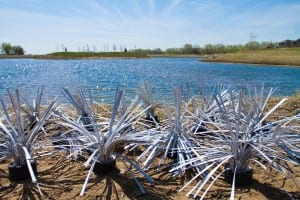Project aims to bring more fish to Smith Mountain Lake with fishiding habitat
4th Sep 2012
Shallow cover for fry.
We recently sent a large order of our habitat products to Ms. Parcell for this project. Read about the spearhead effort to improve and increase habitat in their home waters.
Forte, of Franklin County, designed it himself, and now the invention is part of an assortment of habitat devices that will be used to determine how to entice more fish into coves at the lake.
With the help of Internet research, Forte built a similar pyramid habitat and installed it under his boathouse a few years ago. He said it caused a “dramatic difference” in the number of fish swimming in his cove; today, there are dozens and dozens as opposed to very few.
“I just wanted to see if I could attract some fish,” he said. “And it worked.”
The power company, which uses Smith Mountain and Leesville lakes to produce electricity through a two-reservoir hydroelectric generation dam, hopes to duplicate that kind of success in drawing fish to shallow water areas, said Liz Parcell, a plant manager.
Last week, workers lowered about a dozen similar fish habitat devices in areas shallower than 20 feet in the cove below the Discovery Center at Smith Mountain Lake State Park in Bedford County.
Some of the habitat designs were natural collections of brush and twigs; others were man-made and included cinder blocks, wood pallets and various pipes.
“It’s kind of like a scientific project,” Parcell said.
Some designs resembled objects that might be seen in art galleries, but that will change over time, she said. (possibly the fishiding structures)“They’ll get covered in algae; they won’t look like this for long,” Parcell said.
The goal is to study what designs work and then share that information with lake homeowners, who in turn could use it to create fish habitats of their own.
Next year, the Virginia Department of Game and Inland Fisheries will send scuba divers near the habitats placed in the water to gauge their effectiveness in drawing more fish, Parcell said.
The work is tied to the 30-year license renewal that the Federal Energy Regulatory Commission granted APCo in 2010, she said. The license, which the commission renewed after years of planning and debate among lake-area stakeholders, calls for a habitat-management plan and improvedhabitat along the shoreline.
Lake-area residents and landowners will have to obtain permits from the company before installing the habitats, Parcell said. APCo is working to have that process online, she said, and hopes to have it up and running soon.
“Hopefully, no one gets too excited too quickly,” she said.
By: JUSTIN FAULCONER | The News & Advance
LYNCHBURG, Va. –





